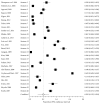Clinical Assessment of the Congenital Absence of Palmaris Longus and Flexor Digitorum Superficialis Muscles in Young Saudi Population
- PMID: 28487773
- PMCID: PMC5405351
- DOI: 10.1155/2017/5342497
Clinical Assessment of the Congenital Absence of Palmaris Longus and Flexor Digitorum Superficialis Muscles in Young Saudi Population
Abstract
Introduction. Congenital Palmaris Longus (PL) absence was found in 15%-20.25% of population globally. This condition and Flexor Digitorum Superficialis (FDS) tendon absence in little finger are not known in Saudi Arabia. We studied prevalence of PL and FDS agenesis in Saudi Arabian population. Methods. A random cross-sectional study was carried out after an ethical approval in the Riyadh universities. Schaeffer's test was used to examine PL absence. The Modified test was used to examine FDS absence. Data was analyzed using Microsoft Excel and the SPSS Software version 22. Results. The volunteers, 331, males 164 (49.5%) and females 167 (50.5%), mean age of 23 (SD ± 5.3), showed right hand dominance in 294 (88.8%) and bilateral absence of PL and FDS in 15.1% and 14.8%, respectively. The hand dominance showed no significant relation between PL and FDS absence, p value = 0.788, 0.835, respectively. Generally, we found a weak correlation between absence of the PL and FDS, p value ≥ 0.595. Conclusion. The bilateral absence of PL and FDS was found as 15.1% and 14.8%, respectively. Variation of the FDS tendon absence was an independent entity for the PL absence. The dominance of hands was not related to the tested variables found in PL and FDS agenesis.
Figures



Similar articles
-
Prevalence of the Absence of the Palmaris Longus and Functional Flexor Digitorum Superficialis of the Little Finger in the Indian Population.Indian J Plast Surg. 2024 Aug 16;57(4):324-328. doi: 10.1055/s-0044-1788932. eCollection 2024 Aug. Indian J Plast Surg. 2024. PMID: 39345668 Free PMC article.
-
Functional absence of flexor digitorum superficialis of the 5th digit and its association with agenesis of palmaris longus.Pak J Med Sci. 2025 Jul;41(7):2041-2045. doi: 10.12669/pjms.41.7.10559. Pak J Med Sci. 2025. PMID: 40735596 Free PMC article.
-
Absence of the palmaris longus tendon in Indian population.Indian J Orthop. 2010 Apr;44(2):212-5. doi: 10.4103/0019-5413.61863. Indian J Orthop. 2010. PMID: 20419011 Free PMC article.
-
Agenesis, functional deficiency and the common type of the flexor digitorum superficialis of the little finger: A meta-analysis.Hand Surg Rehabil. 2018 Apr;37(2):77-85. doi: 10.1016/j.hansur.2017.11.007. Epub 2018 Feb 12. Hand Surg Rehabil. 2018. PMID: 29449159
-
A combined variation of Palmaris longus and Flexor digitorum superficialis: Case report and review of literature.Morphologie. 2016 Dec;100(331):245-249. doi: 10.1016/j.morpho.2016.03.002. Epub 2016 Jun 2. Morphologie. 2016. PMID: 27265750 Review.
Cited by
-
Prevalence of the Absence of the Palmaris Longus and Functional Flexor Digitorum Superficialis of the Little Finger in the Indian Population.Indian J Plast Surg. 2024 Aug 16;57(4):324-328. doi: 10.1055/s-0044-1788932. eCollection 2024 Aug. Indian J Plast Surg. 2024. PMID: 39345668 Free PMC article.
-
Prevalence of Absence of Palmaris Longus Tendon in a Population Sample from a Multiethnic Brazilian City.Rev Bras Ortop (Sao Paulo). 2023 Dec 8;58(6):e891-e895. doi: 10.1055/s-0043-1768617. eCollection 2023 Dec. Rev Bras Ortop (Sao Paulo). 2023. PMID: 38077767 Free PMC article.
-
Anatomical Study of the Palmaris Longus Muscle and Its Clinical Importance.Diagnostics (Basel). 2025 Jan 27;15(3):304. doi: 10.3390/diagnostics15030304. Diagnostics (Basel). 2025. PMID: 39941234 Free PMC article.
-
Functional absence of flexor digitorum superficialis of the 5th digit and its association with agenesis of palmaris longus.Pak J Med Sci. 2025 Jul;41(7):2041-2045. doi: 10.12669/pjms.41.7.10559. Pak J Med Sci. 2025. PMID: 40735596 Free PMC article.
-
Bilateral Congenital Absence of Small Finger Flexor Digitorum Superficialis Tendons in a Trauma Patient.Cureus. 2020 Feb 11;12(2):e6948. doi: 10.7759/cureus.6948. Cureus. 2020. PMID: 32190499 Free PMC article.
References
-
- Drake R. L., Vogl W., Mitchell A. W. M. Gray's Anatomy for Students. 3rd. Philadelphia, Pa, USA: Churchill Livingstone/Elsevier; 2014.
-
- Reimann A. F., Daseler E. H., Anson B. J., Beaton L. E. The palmaris longus muscle and tendon. A study of 1600 extremities. The Anatomical Record. 1944;89(4):495–505. doi: 10.1002/ar.1090890408. - DOI
-
- Igbigbi P. S., Ssekitoleko H. A. Incidence of agenesis of the palmaris longus muscle in Ugandans. West African Journal of Anatomy. 1998;6:21–23.
LinkOut - more resources
Full Text Sources
Other Literature Sources

